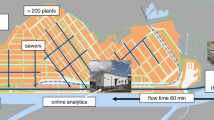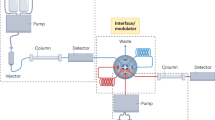Abstract
This paper presents a program to automatize many repetitive manual tasks needed to analyze data from a chromatography of tea samples. We present and explain the main steps of the code altogether with the process in which how raw data are gradually converted into figures and tables and finally a summarized report with them. Our main object was to enable researches to focus on data interpretation and discussion, then manually copying, pasting, and picking this or that set of data and inserting in this or that software to report and organize results. Our code can do in almost 1 h the amount of laborious work that would take a single researcher a whole week to be done.




















Similar content being viewed by others
Notes
We do not know the reason, and thatis not important here.
References
Johnsen LG, Amigo JM, Skov T, Bro R (2014) Automated resolution of overlapping peaks in chromatographic data. J Chemometr 28(2):71–82. https://doi.org/10.1002/cem.2575
Dixon SJ, Brereton RG, Soini HA, Novotny MV, Penn DJ (2006) An automated method for peak detection and matching in large gas chromatography–mass spectrometry data sets. J Chemometr 20(8–10):325–340. https://doi.org/10.1002/cem.1005
Zhan J, Lu S, Meng Z, Xiang N, Cao Q, Miao M (2008) Analysis of volatile components in qingshanlvshui tea using solid-phase microextraction/accelerated solvent extraction-gas chromatography–mass spectrometry. Chin J Chromatogr (Se Pu) 26(3):301–305
Tan S-M, Luo R-M, Zhou Y-P, Xu H, Song D-D, Ze T, Yang T-M, Nie Y (2012) Boosting partial least-squares discriminant analysis with application to near infrared spectroscopic tea variety discrimination. J Chemometr 26(1–2):34–39. https://doi.org/10.1002/cem.1423
Chanda S, Hazarika AK, Choudhury N, Islam SA, Manna R, Sabhapondit S, Tudu B, Bandyopadhyay R (2019) Support vector machine regression on selected wavelength regions for quantitative analysis of caffeine in tea leaves by near infrared spectroscopy. J Chemometr 33(10):3172. https://doi.org/10.1002/cem.3172 (e3172 CEM-19-0048.R1)
Diniz PHGD, Gomes AA, Pistonesi MF, Band BSF, de Araújo MCU (2014) Simultaneous classification of teas according to their varieties and geographical origins by using NIR spectroscopy and SPA-LDA. Food Anal Methods 7(8):1712–1718
Skov T, van den Berg F, Tomasi G, Bro R (2006) Automated alignment of chromatographic data. J Chemometr 20(11–12):484–497. https://doi.org/10.1002/cem.1031
Delaporte G, Cladière M, Camel V (2019) Untargeted food chemical safety assessment: a proof-of-concept on two analytical platforms and contamination scenarios of tea. Food Control 98:510–519. https://doi.org/10.1016/j.foodcont.2018.12.004
Delaporte G, Cladière M, Jouan-Rimbaud Bouveresse D, Camel V (2019) Untargeted food contaminant detection using UHPLC-HRMS combined with multivariate analysis: feasibility study on tea. Food Chem 277:54–62. https://doi.org/10.1016/j.foodchem.2018.10.089
Li S, Lo C-Y, Pan M-H, Lai C-S, Ho C-T (2013) Black tea: chemical analysis and stability. Food Funct 4(1):10–18
Kundu PK, Kundu M (2016) Classification of tea samples using svm as machine learning component of e-tongue. In: 2016 international conference on intelligent control power and instrumentation (ICICPI), pp 56–60. https://doi.org/10.1109/ICICPI.2016.7859673
Zhao J, Chen Q, Cai J, Ouyang Q (2009) Automated tea quality classification by hyperspectral imaging. Appl Opt 48(19):3557–3564. https://doi.org/10.1364/AO.48.003557
Luo R-M, Tan S-M, Zhou Y-P, Liu S-J, Xu H, Song D-D, Cui Y-F, Fu H-Y, Yang T-M (2013) Quantitative analysis of tea using ytterbium-based internal standard near-infrared spectroscopy coupled with boosting least-squares support vector regression. J Chemometr 27(7–8):198–206. https://doi.org/10.1002/cem.2518
Kovács Z, Dalmadi I, Lukács L, Sipos L, Szántai-Kõhegyi K, Kókai Z, Fekete A (2010) Geographical origin identification of pure Sri Lanka tea infusions with electronic nose, electronic tongue and sensory profile analysis. J Chemometr 24(3–4):121–130. https://doi.org/10.1002/cem.1280
Ridder L, van der Hooft JJJ, Verhoeven S, de Vos RCH, Bino RJ, Vervoort J (2013) Automatic chemical structure annotation of an LC-MSN based metabolic profile from green tea. Anal Chem 85(12):6033–6040. https://doi.org/10.1021/ac400861a (PMID:23662787)
Li M, Wang S, Xie G, Ma X, Chen T, Jia W (2017) polyPK: an R package for pharmacokinetic analysis of multi-component drugs using a metabolomics approach. Bioinformatics 34(10):1792–1794. https://doi.org/10.1093/bioinformatics/btx834
Zucatelli FHG (2019) Matlab to LaTeX Library. File Exchange. https://www.in.mathworks.com/matlabcentral/fileexchange/72155-matlab-to-latex-library. Accessed 20 Feb 2020
Zucatelli FHG (2019) Matlab to MSWord function library. File Exchange. https://www.mathworks.com/matlabcentral/fileexchange/74279-matlab-to-msword-function-library. Accessed 24 Nov 2021
Zucatelli FHG (2021) Tea component analysis. File Exchange. https://www.mathworks.com/matlabcentral/fileexchange/88356-tea-component-analysis. Accessed 24 Nov 2021
Zucatelli FHG (2019) File manipulation library. File Exchange. https://in.mathworks.com/matlabcentral/fileexchange/72155-matlab-to-latex-library. Accessed 20 Feb 2020
Zucatelli FHG (2019) Search and replace a WordSet library. File Exchange. https://www.mathworks.com/matlabcentral/fileexchange/61226-search-and-replace-a-wordset-library. Accessed 20 Feb 2020
Wikipedia: ActiveX. Wikipedia (2019). https://www.pt.wikipedia.org/wiki/ActiveX. Accessed 10 Sept 2021
Swartz M (2019) xlswrite1. File Exchange. https://www.mathworks.com/matlabcentral/fileexchange/10465-xlswrite1. Accessed 20 April 2020
Acknowledgements
Authors are grateful to financial support from the Brazilian Coordination for the Improvement of Higher Education Personnel (CAPES 001) and advisors Rodinei Augusti and Brenda Félix for their support and contribution.
Author information
Authors and Affiliations
Corresponding author
Ethics declarations
Conflict of interest
We declare there is no conflict of interest.
Additional information
Publisher's Note
Springer Nature remains neutral with regard to jurisdictional claims in published maps and institutional affiliations.
Rights and permissions
About this article
Cite this article
Zucatelli, F.H.G., Nogueira, R.K. Tea Component Analysis: From Chromatography Raw Data to a Fully Automated Report. Chromatographia 85, 193–211 (2022). https://doi.org/10.1007/s10337-021-04118-8
Received:
Revised:
Accepted:
Published:
Issue Date:
DOI: https://doi.org/10.1007/s10337-021-04118-8




